Top Opsgenie Alternatives to Migrate To Before April 2027
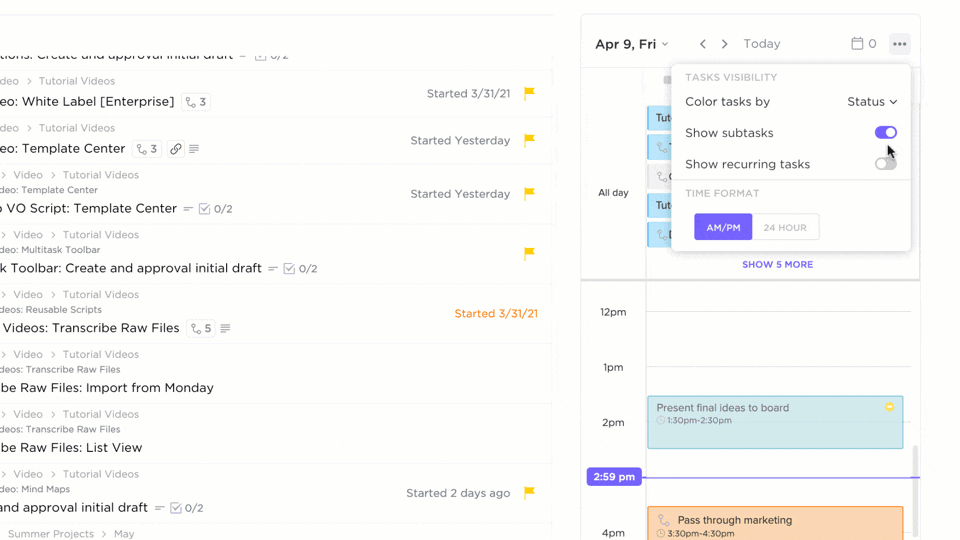
Sorry, there were no results found for “”
Sorry, there were no results found for “”
Sorry, there were no results found for “”

Ever been in the middle of dinner when your phone buzzes with a “critical alert” that turns out to be nothing more than routine logs? It’s frustrating, but at least you knew Opsgenie had your back.
Now comes the real challenge: Atlassian has stopped selling Opsgenie, and soon, full support will end. For teams that rely on it for on-call scheduling, escalations, and alerts, that’s a wake-up call no one wanted.
The good thing is, you don’t have to wait until the last minute. Giving yourself time to explore other options now means your team can settle into a new routine without the stress of rushed decisions.
In this article, we’ll walk through the best Opsgenie alternatives, compare their strengths, and show why ClickUp offers your team a calmer and more connected way to work.
Allow your IT teams to log incidents accurately and surface trends that inform long-term improvements. ClickUp’s IT Incident Report Template helps you record incident details in a consistent and reliable format.
Here’s a quick comparison of the best Opsgenie alternative options to help you choose the right fit based on key features, pricing, and user ratings.
| Tool | Best for | Key features | Pricing* | Ratings |
| ClickUp | All-in-one work management with incident workflows, resource planning, and automation for teams of all sizes | Customizable notifications, automation for escalations, incident tasks and lists, custom statuses, real-time chat, dashboards for post-incident reviews, 1,000+ integrations | Free plan available; customizations for enterprises | G2: 4.7/5 (10,500+) Capterra: 4.6/5 (4,500+) |
| PagerDuty | Real-time incident alerting and automation at scale for large companies | Multi-channel alerts, escalation policies, on-call scheduling, AIOps for noise reduction, integrations with 600+ tools | Free plan; Paid plans from $25/month per user | G2: 4.5/5 (900+) Capterra: 4.6/5 (200+) |
| xMatters | Cost-effective incident management and workflow automation for growing teams | Automated workflows, adaptive incident management, on-call scheduling, signal intelligence, 200+ integrations | Free plan; Paid plans from $9/month per user | G2: 4.5/5 (670+) Capterra: 4.6/5 (140+) |
| AlertOps | AI-powered noise reduction and rapid response for small to mid-sized teams | AI OpsIQ noise reduction, flexible escalations, on-call coverage, no-code workflow automation, 200+ integrations | Free plan; Paid plans from $10/month per user | G2: 4.7/5 (150+) Capterra: 4.7/5 (20+) |
| Splunk On-Call | Simplifying on-call scheduling and reducing burnout for large teams | Automated escalations, mobile apps, workload balancing, ML recommendations, audit trails | Custom pricing | G2: 4.6/5 (50+) Capterra: 4.5/5 (30+) |
| Datadog | Full-stack observability with security monitoring for enterprises | Infra + log + app monitoring, cloud security, anomaly detection with AI, 900+ integrations | Free plan; Paid plans from $15/month per user | G2: 4.4/5 (660+) Capterra: 4.6/5 (320+) |
| Squadcast | Unified on-call and incident response with value pricing for mid-sized teams | Automated schedules, deduplication, runbooks, status pages, postmortems | Free plan; Paid plans from $12/month per user | G2: 4.4/5 (300+) Capterra: Not enough reviews |
| FireHydrant | Automated runbooks and service ownership for enterprises | Runbooks, Signals on-call scheduling, Service Catalog, Slack/Teams collaboration, AI-enriched retrospectives | Free plan; Paid plans from $9,600/year per user | G2: 4.5/5 (130+) Capterra: Not enough reviews |
| TaskCall | Affordable incident management with automation for mid-sized to large teams | Dynamic on-call scheduling, AI-powered routing, multi-channel alerts, DevOps + BizOps coverage | Free plan; Paid plans from $9/month per user | G2: Not enough reviews Capterra: Not enough reviews |
| ilert | AI-first incident management with privacy focus for scaling teams | Multi-channel alerts, AI Responder assistant, on-call scheduling, automated status pages, integrations with ITSM + monitoring tools | Free plan; Paid plans from $24/month per user | G2: Not enough reviews Capterra: 4.7/5 (60+) |
| Zenduty | AI-driven incident response at scale for small to large teams | ZenAI incident management, advanced on-call scheduling, automated playbooks, 150+ integrations | Free plan; Paid plans from $6/month per user | G2: 4.6/5 (135+) Capterra: Not enough reviews |
| Incident.io | Slack-native incident response for mid- to large-sized companies | End-to-end incidents in Slack, AI SRE, on-call scheduling, automated status pages, insights dashboards | Free plan; Paid plans from $19/month per user | G2: 4.8/5 (180+) Capterra: Not enough reviews |
I know we have 2 years almost before they fully retire it, but I see no reason to wait 😛
That comment by a Reddit user captures the reality that many IT PMO teams are facing. Yes, Opsgenie was a good companion for years, but relying on it only because it’s familiar won’t help once support ends.
The thoughtful thing to do now is to look at what made Opsgenie useful in the first place and use those same qualities as a guide when choosing your next incident management platform.
Here are some of the characteristics worth paying attention to:
Opsgenie built its reputation on helping DevOps teams reduce alert fatigue, stay clear on on-call schedules, and resolve incidents without confusion. As you explore each Opsgenie alternative, hold these same values close.
📖 Also Read: Top Incident Management Software Tools for IT Teams
Opsgenie may be winding down, but that doesn’t mean your team has to lose momentum. Here are some suitable replacements that will give your operations teams confidence during critical moments.
Our editorial team follows a transparent, research-backed, and vendor-neutral process, so you can trust that our recommendations are based on real product value.
Here’s a detailed rundown of how we review software at ClickUp.
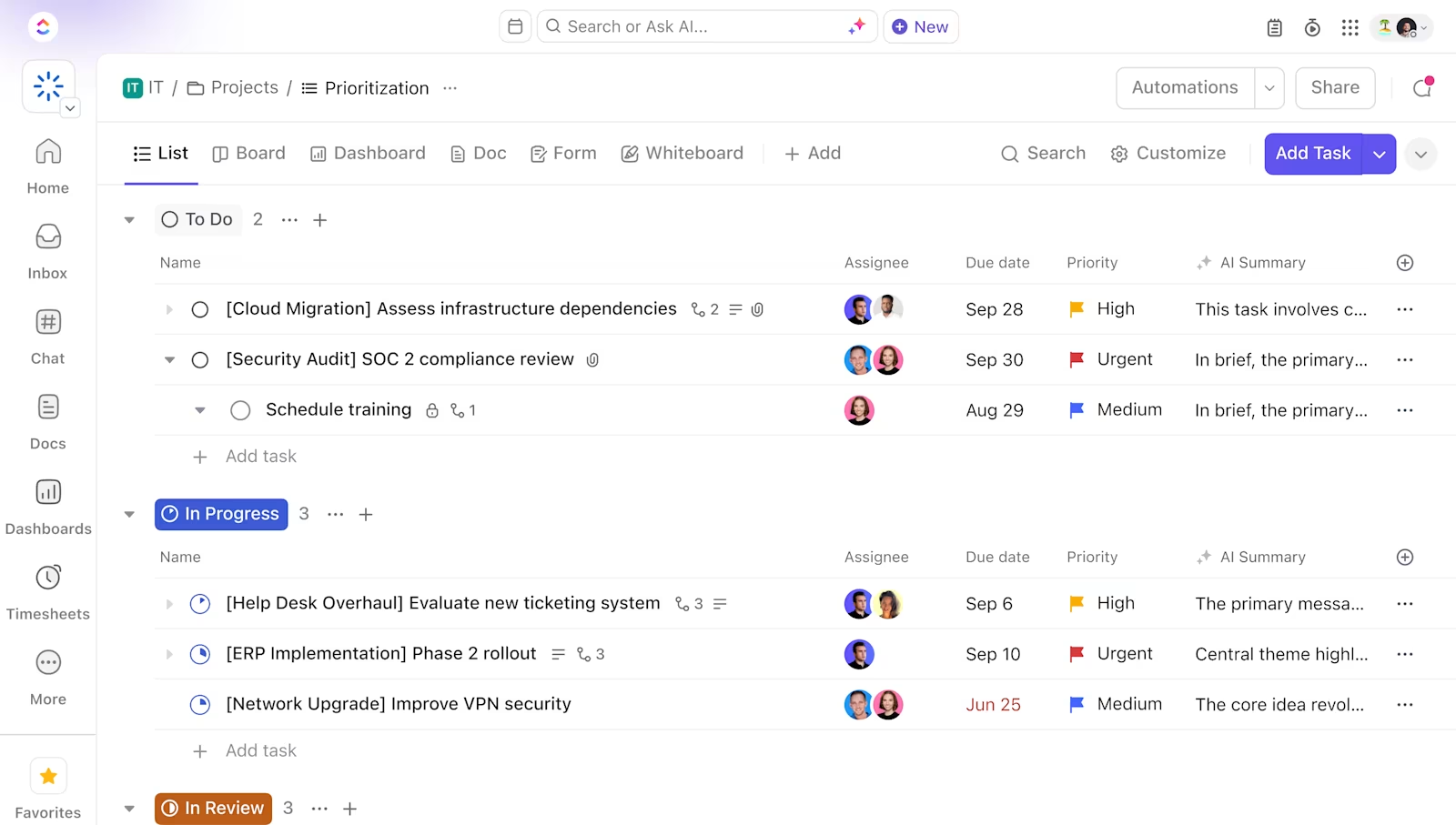
When leaving Opsgenie, teams worry less about losing alerts and more about adapting to a new incident management workflow.
The core problem is Work Sprawl, where updates, schedules, and policies are scattered across different apps, emails, and documents. This fragmentation drains energy and forces teams to start from scratch during every incident.
Research shows that employees spend 117 minutes digging through emails and 153 minutes on Microsoft Teams messages per weekday, with interruptions every couple of minutes.
ClickUp steps in as an Opsgenie alternative by pulling all of that disconnected work into one converged workspace. Here is how its features meet those challenges in depth.
Automated response workflows
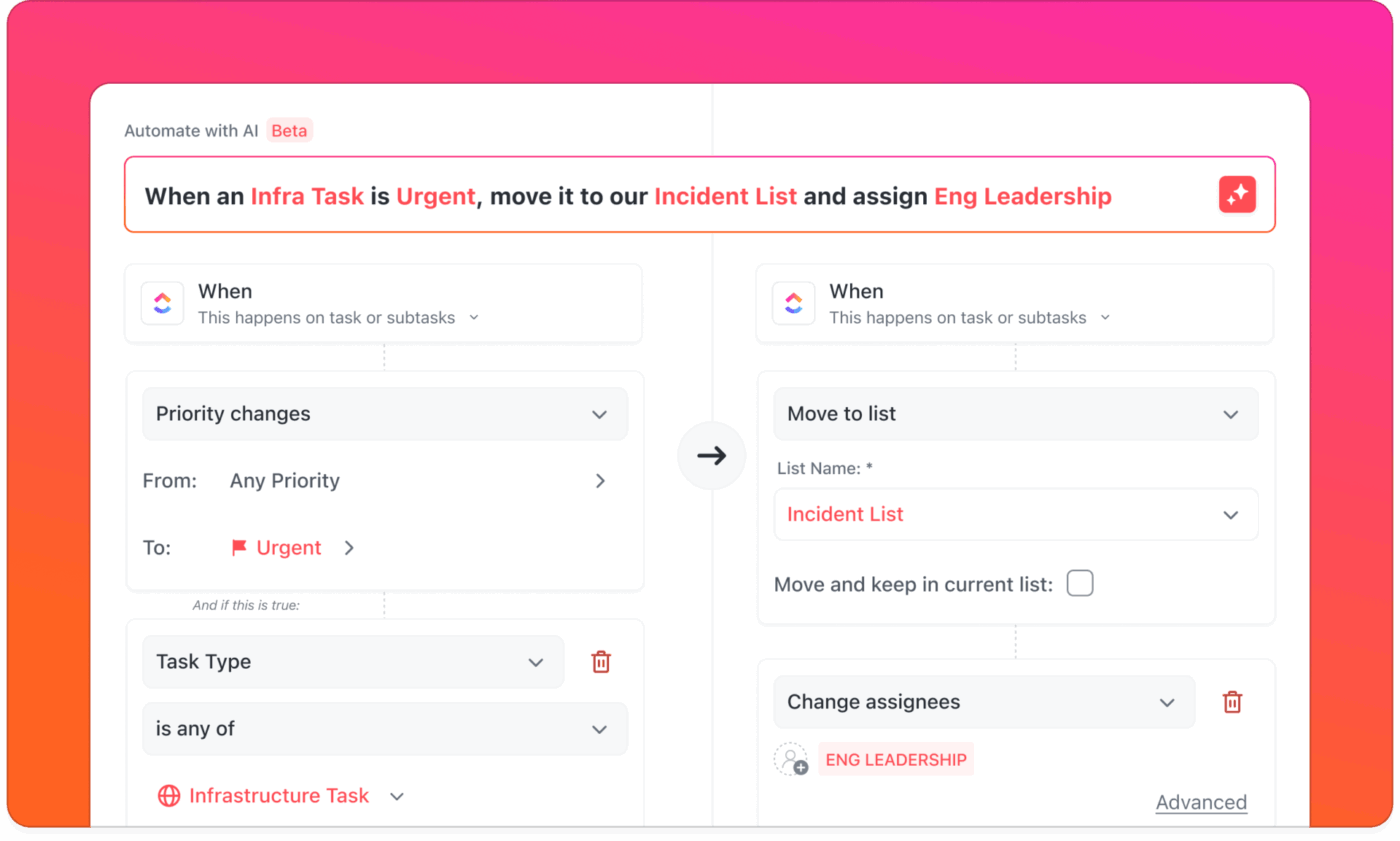
With alerts coming from monitoring tools, chat tools, and email, it is hard to tell what matters and who should respond.
With ClickUp Automations and AI Agents, alerts become meaningful actions. Incoming alerts can automatically create and assign tasks to the on-call engineer, notifying the right person without distracting the rest of the team.
If there’s no response within a set time, the system automatically escalates the issue according to your standard procedures.
📌 Example: A high-priority server outage is reported. ClickUp Automations creates a new task in your Incidents list, marks it as urgent, assigns it to the on-call engineer, and sends a mobile push alert. At the same time, your custom AI Agent posts a short message in the incident channel in ClickUp Chat so the team is informed but not overwhelmed.
Clarity and accountability around tasks
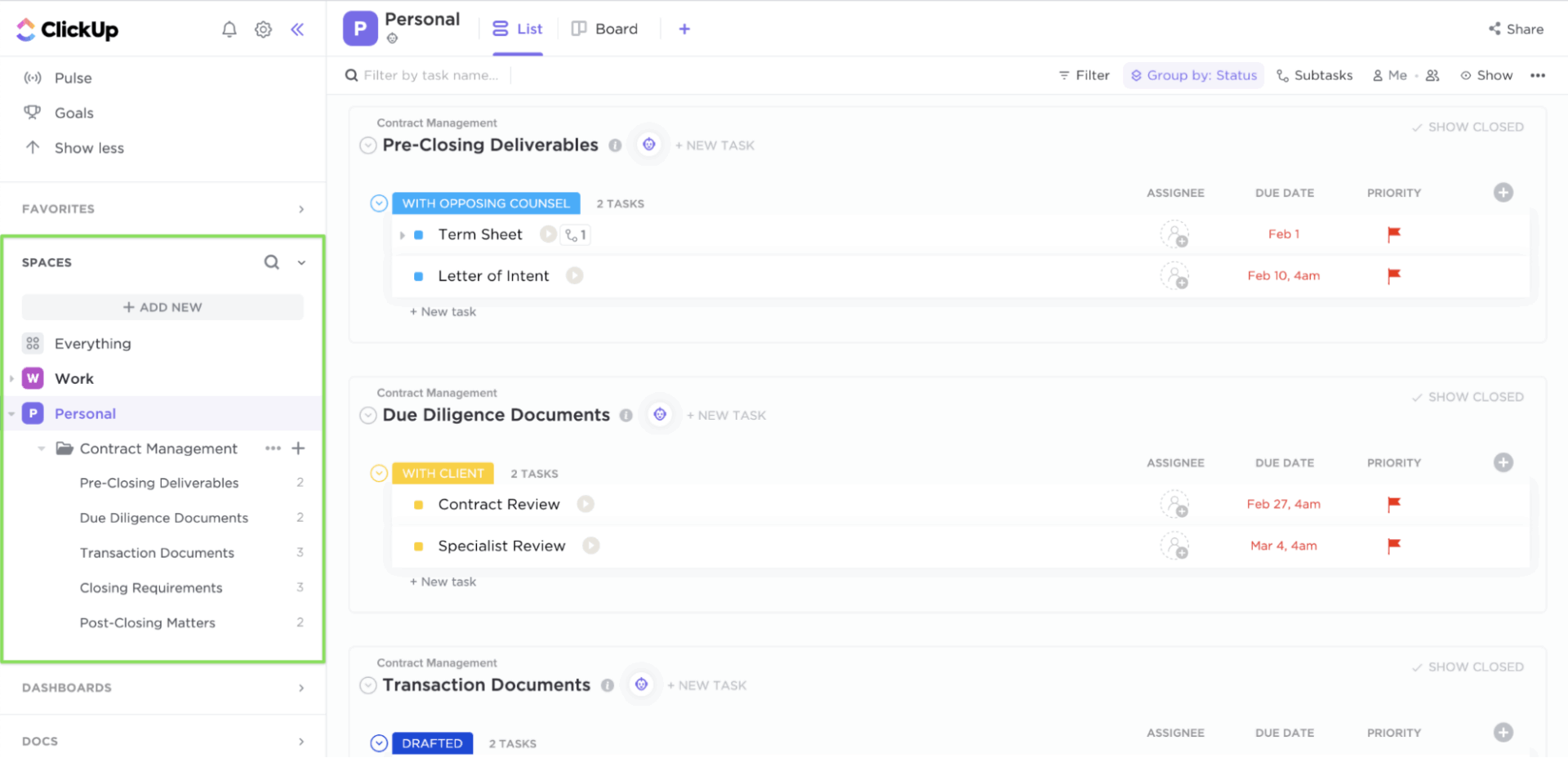
When an incident unfolds, teams often waste time figuring out what to do and what comes next. ClickUp Tasks brings clarity to your incident management processes.
Each task can have a clear owner, priority, and due time. Within each task, you can add checklists, runbook links, and screenshots. Custom Fields capture severity, affected services, or escalation stage, while ClickUp Custom Task Statuses and lists remove uncertainty by mapping the response process into a clear sequence.
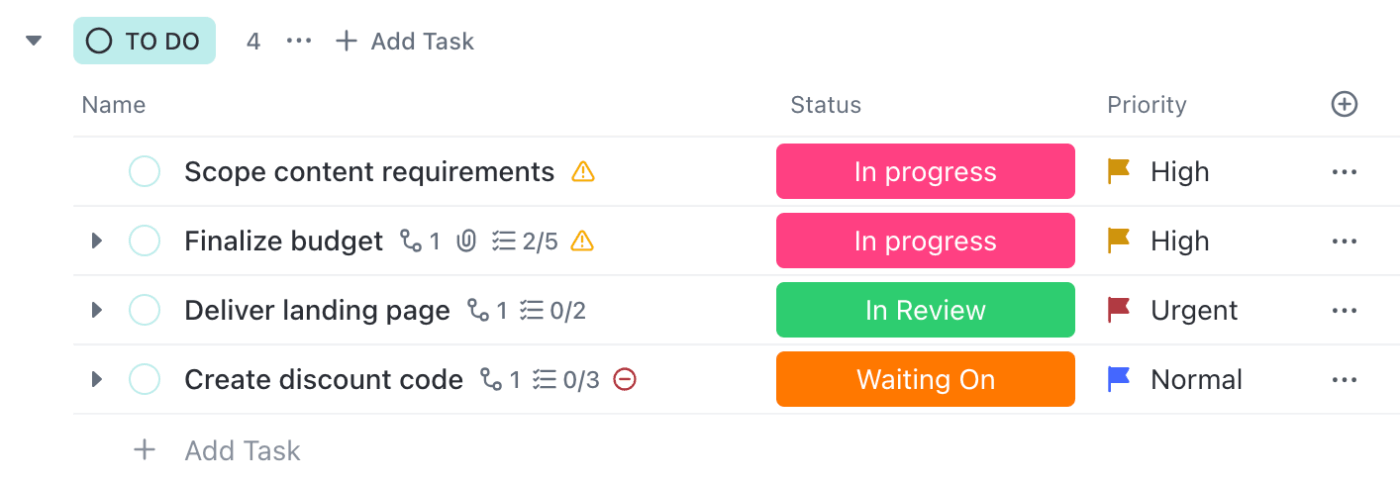
📌 Example: A ‘Reported’ incident moves to ‘Investigating’ once the engineer opens the task. Mitigation steps are tracked in a checklist, with notes and logs added in the description. Each status change notifies only the relevant people, so engineers can work while leaders stay informed.
Updates that don’t break the flow of work
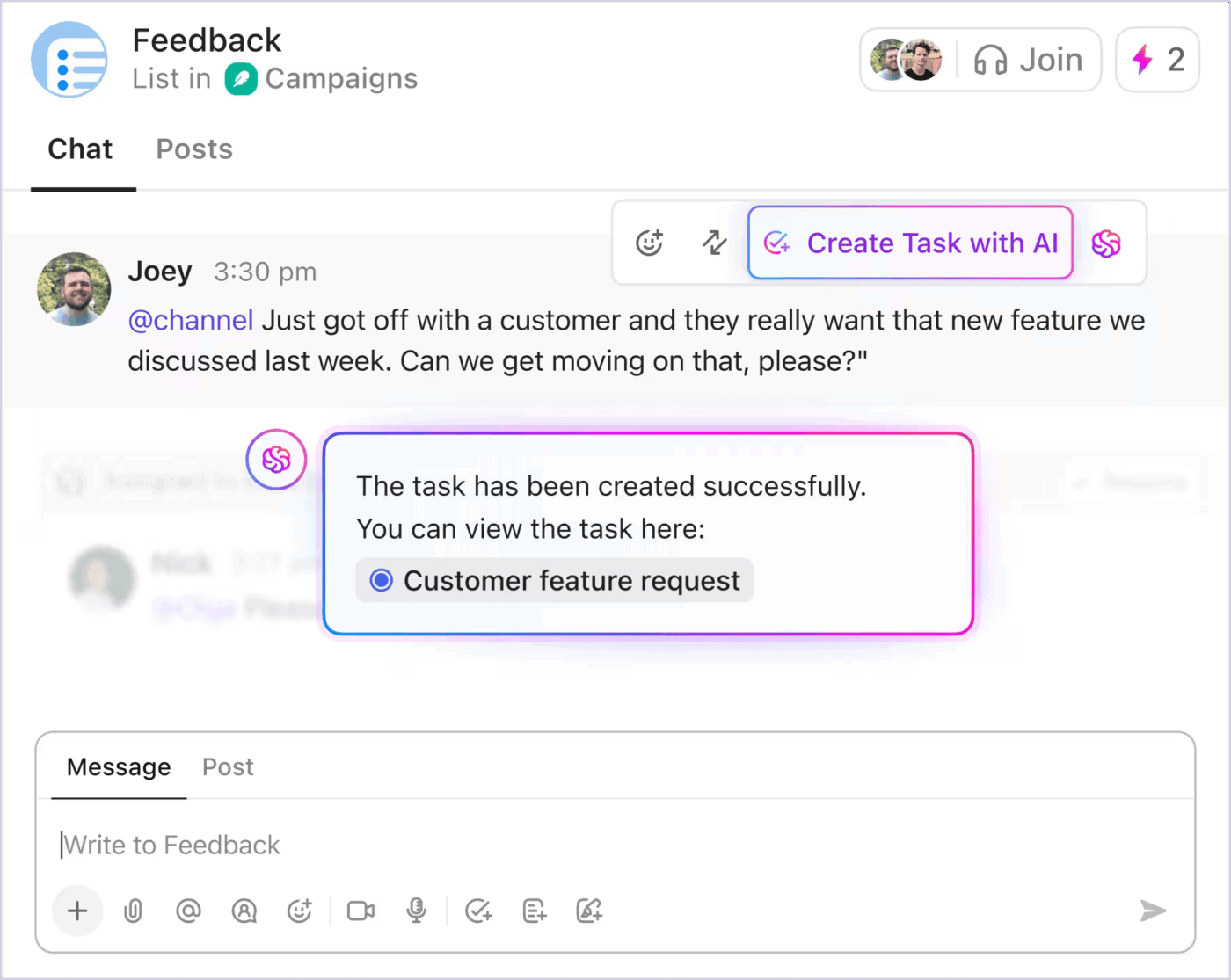
During critical incidents, stakeholder updates shouldn’t interrupt the response effort. ClickUp Chat solves this by attaching the conversation directly to the incident task. Team members and leaders can follow the thread, see decisions made, and add comments in real time.
ClickUp also integrates with Slack and Microsoft Teams, allowing updates to appear in the channels people already follow.
Looking for the best tips when it comes to real-time collaboration? Here’s a guide:
Post-incident reviews that lead to lasting change
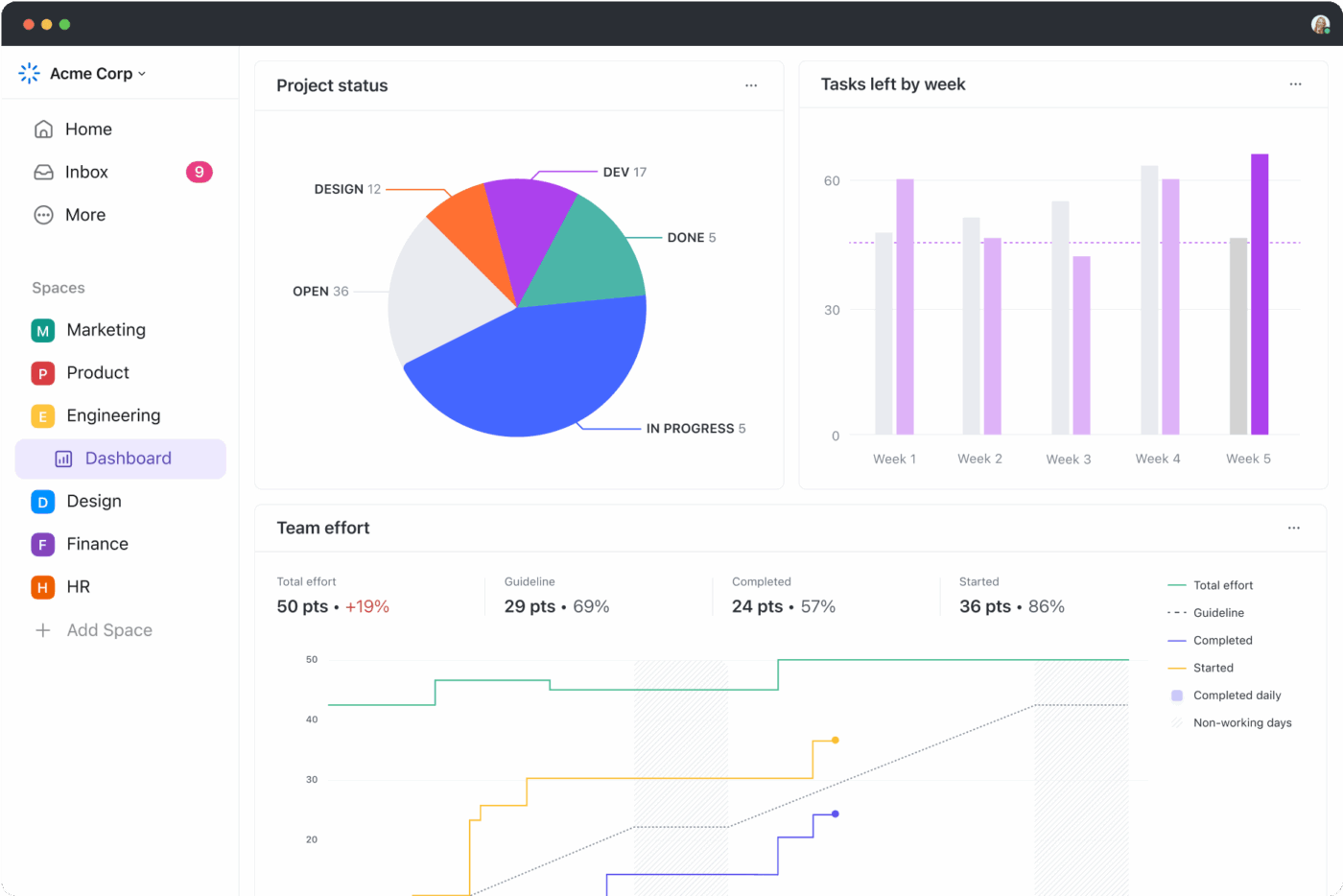
Too often, post-incident reviews are written but forgotten. ClickUp Docs keeps them alive by storing standardized postmortems directly alongside incident tasks.
Meanwhile, ClickUp Dashboards display metrics such as mean time to resolution, incident frequency, and recurring patterns. This visibility helps IT teams and DevOps teams move from reactive firefighting to proactive improvement.
💡 Pro Tip: Post-incident reviews can take hours of writing, editing, and digging for context. ClickUp Brain changes that by pulling together notes, timelines, and action items automatically. It can summarize an incident task, draft a postmortem in ClickUp Docs, and even suggest next steps based on similar incidents.
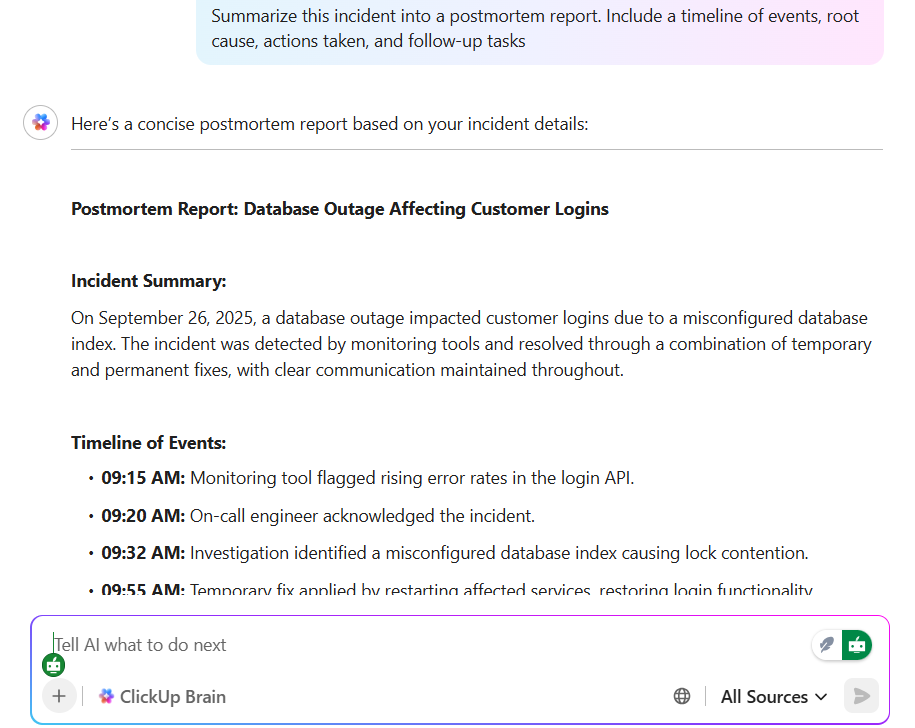
With ClickUp Brain Max, you get the added speed of ClickUp’s Talk to Text—dictate your thoughts in real time and watch them turn into polished notes that are ready to share. Together, they help teams save almost a full day each week by cutting out the busywork of writing and searching, so you can focus on preventing the next incident instead of retelling the last one.
Bring structure and save time with templates
In an emergency, you truly learn to appreciate the value of a clear, step-by-step process.
ClickUp’s Incident Action Plan Template is exactly that. This lays out exactly what needs to be done, who needs to do it, and in what order. It keeps everyone aligned, reduces risks, and ensures no step is overlooked.
Another challenge in IT is documenting incidents effectively so patterns can be spotted and prevented in the future. ClickUp’s IT Incident Report Template makes reporting straightforward, turning every issue into a valuable data point.
This G2 user reported:
Working together on a project became much easier since the implementation of click up since task can be easily assigned to members and you can catch up on progress through chatting. It even goes ahead to give email notifications and overdue alert Incase of an undone task.
📖 Also Read: How to Write an Incident Report at Work
If you are leaving Opsgenie, your first worry is simple. Will the right person get the alert, at the right moment, on the right channel?
PagerDuty is built to remove that stress. You define services, schedules, and clear escalation policies so ownership is never in doubt. Signals from CloudWatch, Prometheus, Datadog, Jira, ServiceNow, Slack, Zoom, and more land in one place and are grouped into a single incident, not 15 separate pings.
Event Intelligence reduces duplicates and correlates related issues, which cuts alert fatigue without muting real problems. Responders can acknowledge or escalate from the mobile app or straight from Slack or Teams, with incident rooms and bridges created automatically.
After resolution, analytics surface time to acknowledge, time to resolve, and recurring hotspots so you can fix root causes rather than chase symptoms.
This G2 user mentioned:
I love that pager duty has several different audible alerts, some of them are hilarious. Since picking up pager duty, I’ve been able to respond to incident and engage teams more efficiently.
📖 Also Read: What is a Contingency Plan & How to Develop One?
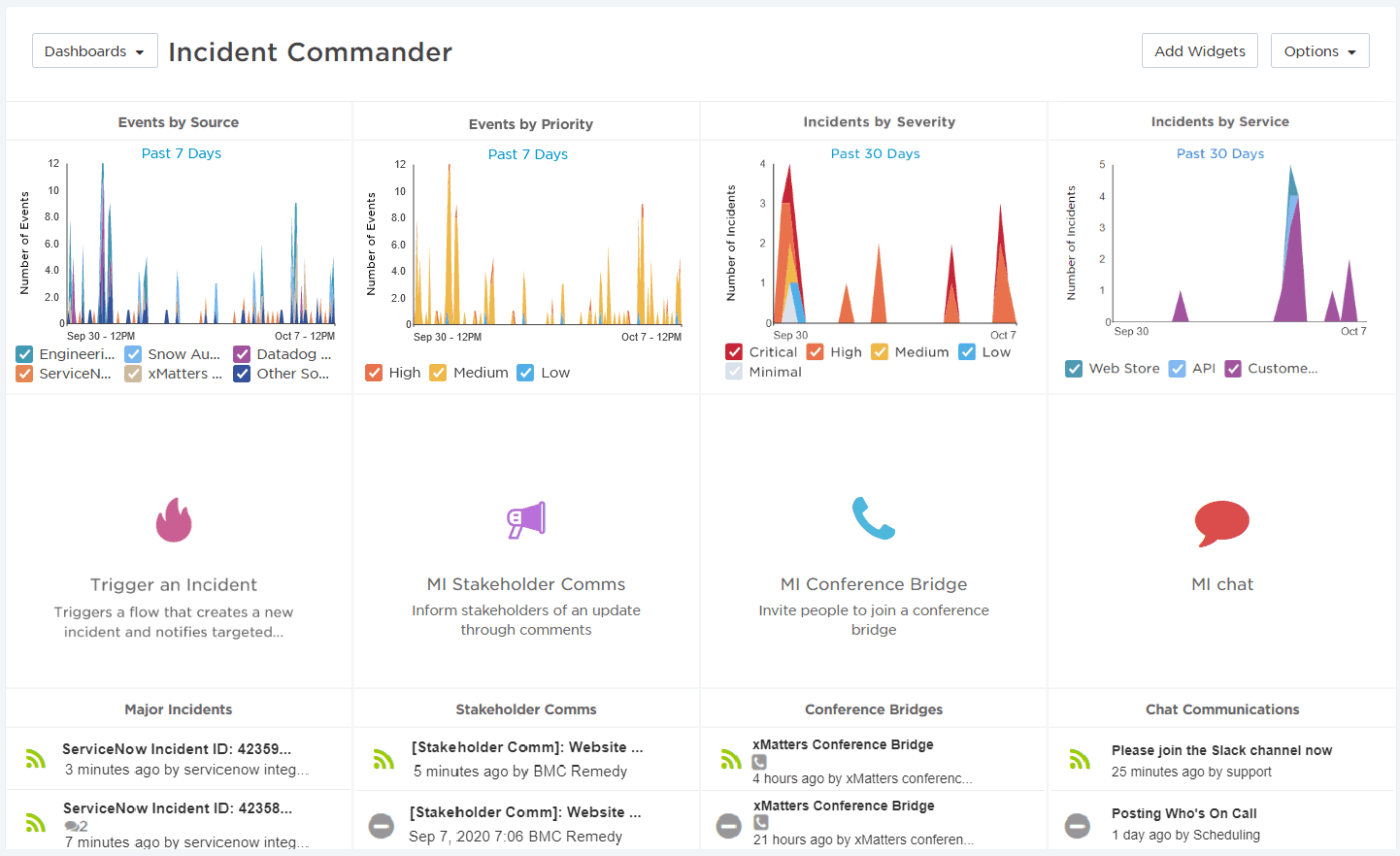
A Reddit user summed it up best:
You get what you pay for, but you pay less. Has all the things you want, tho definitely it’s not as fancy as PagerDuty.
That line captures xMatters’ positioning—affordable, reliable, and strong in the areas that matter most.
If you are leaving Opsgenie, your pain is usually twofold. Too much noise that wakes the wrong people, and uncertainty about who owns the next move. xMatters tackles both by letting you map services and on-call schedules, then route alerts with precise context so the right person is reached on the right channel.
Users have appreciated targeted notifications with useful details, plus a full audit trail that shows who was paged, who acknowledged, and when. That record makes post-incident reviews and compliance checks straightforward.
The low-code workflow builder turns a signal from Datadog, Prometheus, or ServiceNow into a clear sequence of actions.
With workflow automation and adaptive DevOps project management at its core, xMatters helps teams move faster and cut through alert noise.
This Capterra review featured:
When we have a data security incident in the company, Xmatters activates the response protocols immediately: it organizes the team’s action protocols according to their functions. Notifications are sent through various.
📮 ClickUp Insight: 28% of employees say work follows them after hours, and another eight percent often struggle to switch off. That is more than a third bringing stress home.
Use ClickUp Reminders to protect your evening routine. Set a daily wrap-up reminder, quiet notifications outside work hours, and reserve personal time on your calendar. Switching off should be a choice you make.
💫 Real Results: Lulu Press saves about one hour per person each day with ClickUp Automations, leading to a 12% boost in efficiency.
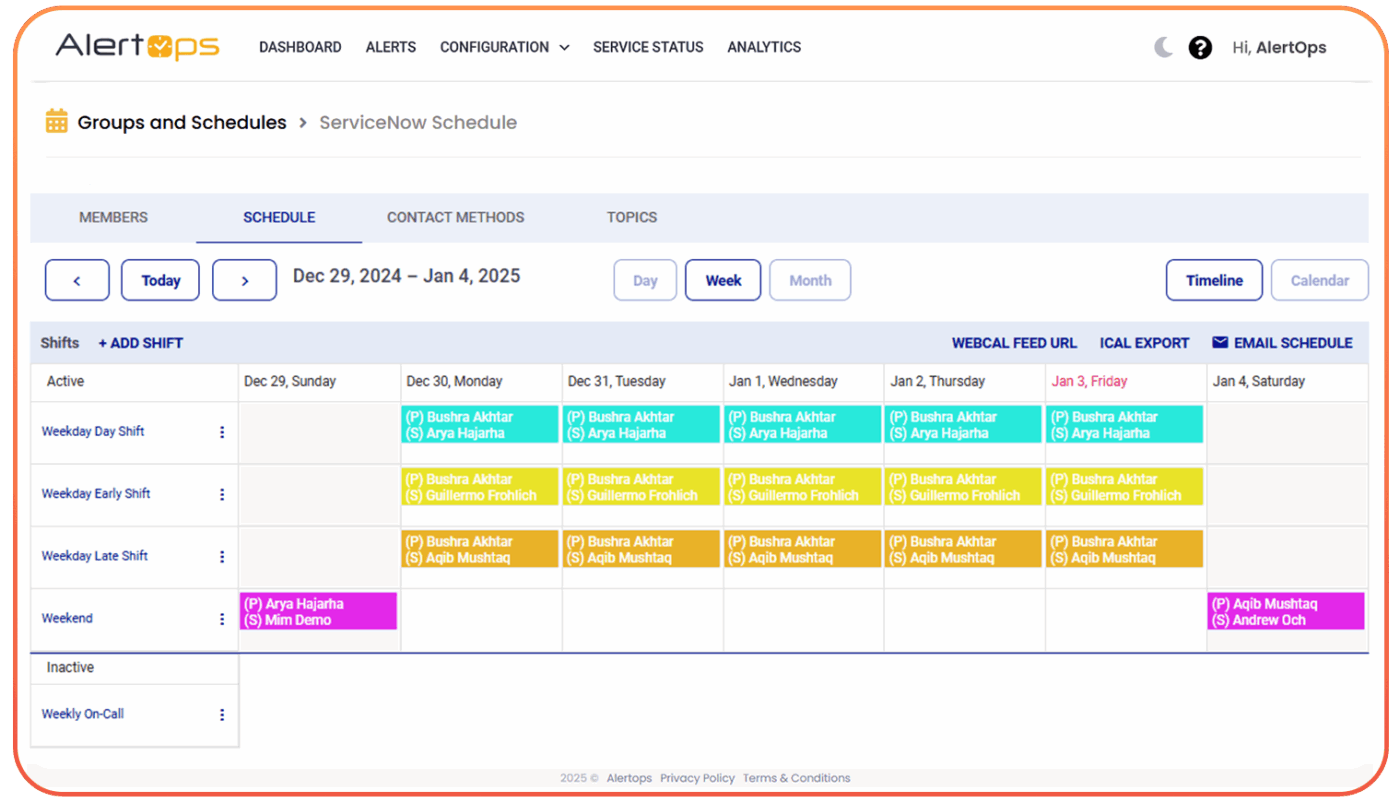
Alert volume continues to rise, with 88% of teams reporting an increase in the past year and nearly half saying those spikes were over 25%. That kind of constant noise leads to alert fatigue, which 76% of SOCs (Security Operations Centers) now cite as their top challenge.
That is the reality you bring into any Opsgenie replacement. The next tool you pick has to be able to judge which alerts deserve action. AlertOps leans into that with OpsIQ, an AI core that filters duplicates, correlates related signals, summarizes context, and suggests next steps so responders see one clear incident instead of a scrolling feed.
You can start with the default on-call schedule or build your own, then route by phone, SMS, mobile app, chat, or email with escalation rules that keep working until someone owns the issue. Live call routing sends customers to the current on-call staff based on real-time schedules, and SLA-based policies escalate before a breach rather than after.
Additionally, the platform integrates with more than 200 tools, from monitoring and ticketing to O365 and Slack, so triage doesn’t stall on missing context.
This G2 review makes it clear:
We spent the better part of Q3 last year auditioning Schedule/Alerting tools for one of our IT Teams. After Finding AlertOps I stopped looking, its affordable, there team is incredibly helpful and patient in the set up process and implementation, and since getting things fully set up and running we have had 0 issues!
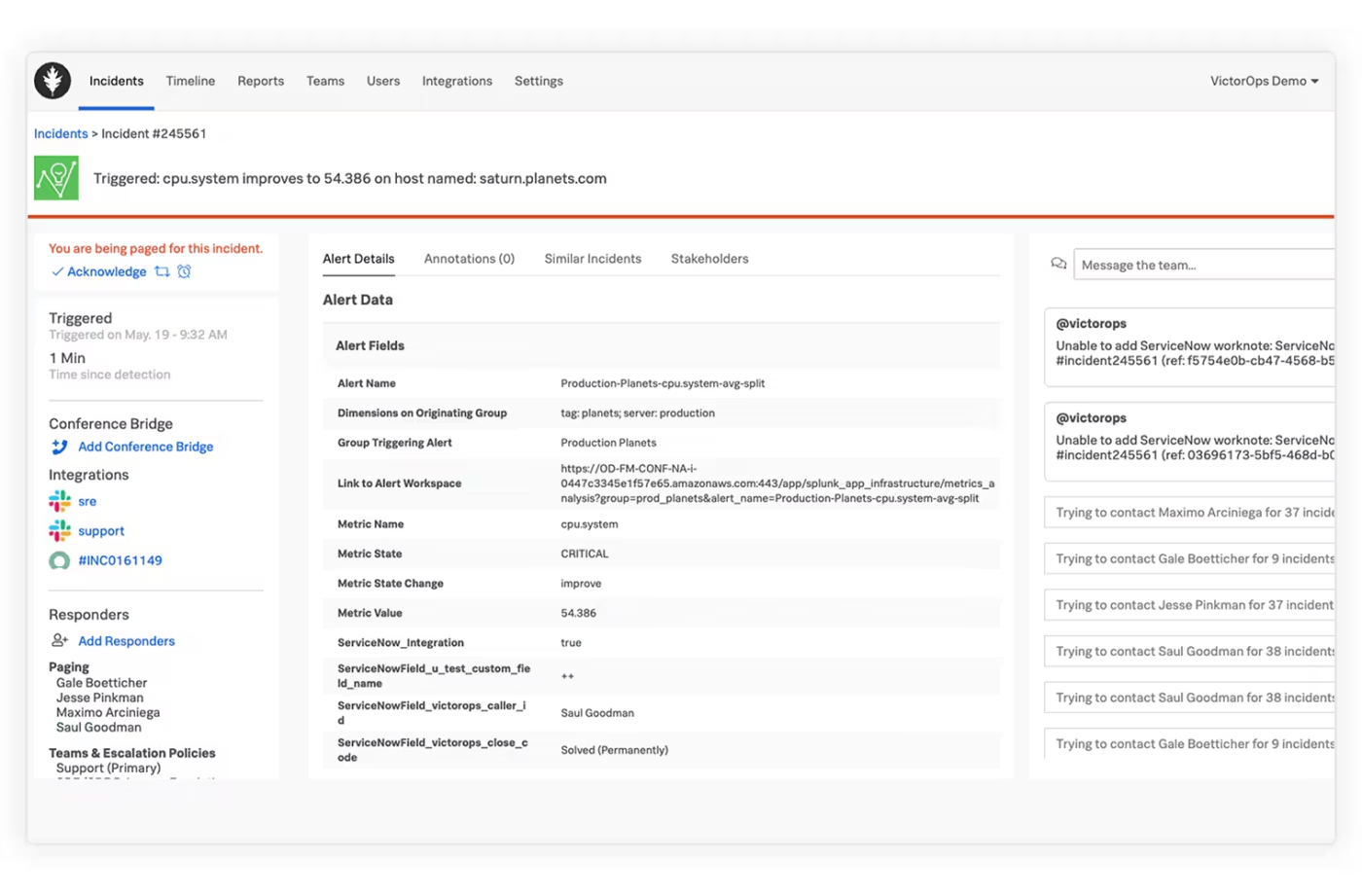
If you’ve ever watched the classic Abbott and Costello “Who’s on First?” routine, you know the confusion of trying to figure out who’s actually responsible for what. On-call rotations can feel the same way when there’s no clear system in place.
That’s where Splunk On-Call steps in. ✨
You map teams and schedules once, then alerts arrive with context on any device. Responders can acknowledge, reroute, or snooze from the iOS or Android app, and the platform can open a room for collaboration and start the post-incident review without extra steps.
A rules engine attaches runbooks and dashboards to incidents so the first person paged never starts cold. Machine learning suggests the right responders based on similar incidents, which helps cut time to acknowledge and resolve.
This G2 review notes:
Being able to create teams and configure shifts between them is one of the most helpful resources available on this platform. Splunk On-Call provides easy integrations with several tools making its configuration very easy to set up.
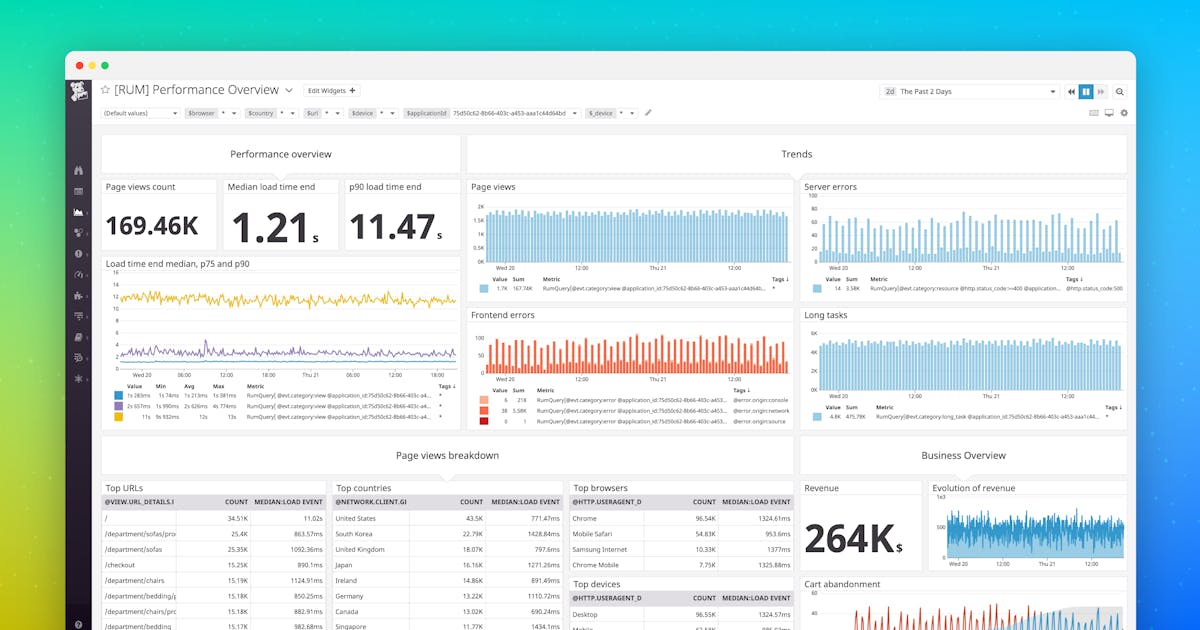
For Opsgenie users, the pain is context. An alert fires, but you still have to hunt for logs, traces, metrics, and security signals to know what is actually broken.
Datadog pulls those views into a single timeline. Infrastructure, containers, serverless, databases, and apps sit next to logs, traces, and RUM so responders don’t have to guess.
Watchdog and the new AI capabilities highlight anomalies, group related signals, and summarize probable impact, which cuts the back and forth during triage. If you already have a paging tool, you can feed Datadog alerts into it.
If you want to stay inside Datadog, Incident Management gives you owners, timelines, stakeholder updates, and follow-ups without leaving the platform.
The practical benefits show up fast. Fewer noisy pings because duplicates roll up. Faster root cause analysis because each alert carries the metrics and logs that explain it. Stronger security posture because misconfigurations and vulnerabilities surface alongside performance data.
With 900+ integrations, clear SLOs (Service Level Objectives), and dashboards, your team can go from signal to fix in one place instead of tab hopping. This is a good choice for Opsgenie migrations that also want to close observability gaps.
This Capterra review quoted:
Overall, after some ups and downs, they’ve been a good partner. Their tool is extremely powerful, and enables a lot of excellent practices around observability, but you have to pay for it.
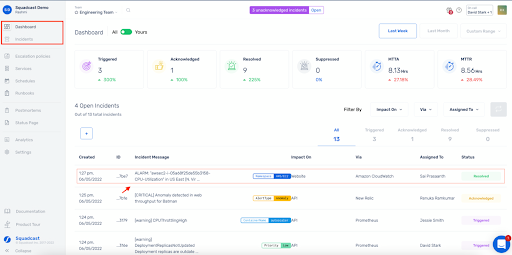
When you’re handling multiple rotas and client-specific after-hours rules, you need alerts to respect those rules without hand-holding.
That is the niche where Squadcast earns trust. 🌟
Users have noted that rotas and overrides are easy to model and that the mobile app will keep escalating if the first responder doesn’t answer, so critical issues don’t slip.
For MSPs and teams with many customers, people like that you can set 24/7 coverage for certain clients while letting others trigger after-hours alerts only for critical incidents. The UI makes it easy to see active incidents and who is on point.
There is more under the hood than paging. Reliability automation moves incidents through consistent workflows with runbooks and status updates, SLO tracking and timelines surface patterns you can actually act on, and pricing is transparent enough that smaller teams don’t feel locked out.
This G2 review mentioned:
Squadcast can take inputs from various monitoring tools that we have and its easy to set up rotas and overrides for who should be alerted for different types of issues.
📖 Also Read: Cybersecurity Risk Management
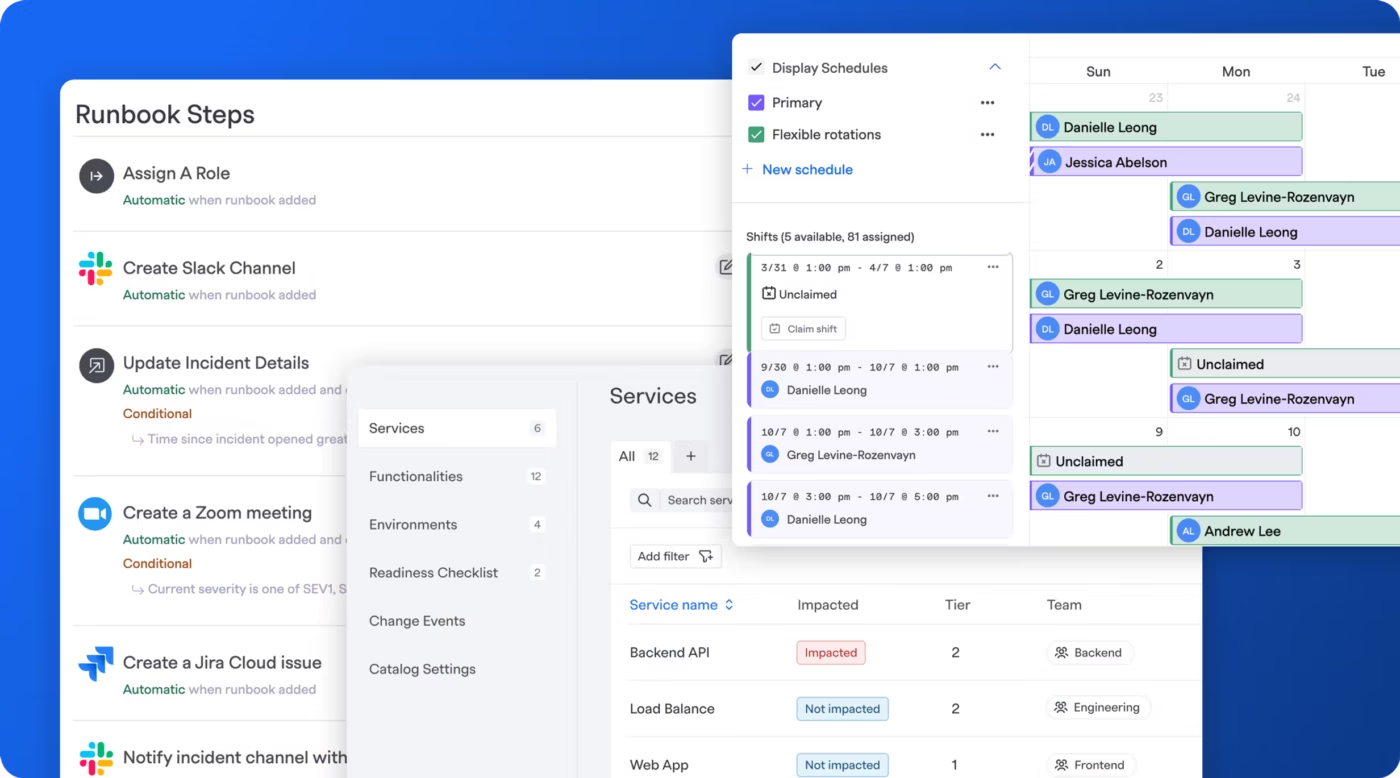
This incident management software offers a well-structured process that keeps services running smoothly.
FireHydrant centers responses around runbooks, a service catalog, and a shared workspace. Declare an incident and the platform spins up a channel in Slack or Teams, attaches the right runbook, pulls ownership from the service catalog, and begins an auditable timeline.
Meanwhile, its AI keeps the overhead low with instant incident summaries, suggested stakeholder updates, and live meeting transcripts so the team can stay focused on mitigation rather than note-taking.
Teams also highlight responsive support and an API first approach with Terraform that lets ops leaders wire FireHydrant into existing workflows without friction.
This G2 user captured:
Working fully out of Slack or some other chat/collaboration tool, FireHydrant integrates and lets you open/update/resolve incidents without having to leave where the incident response action is happening.
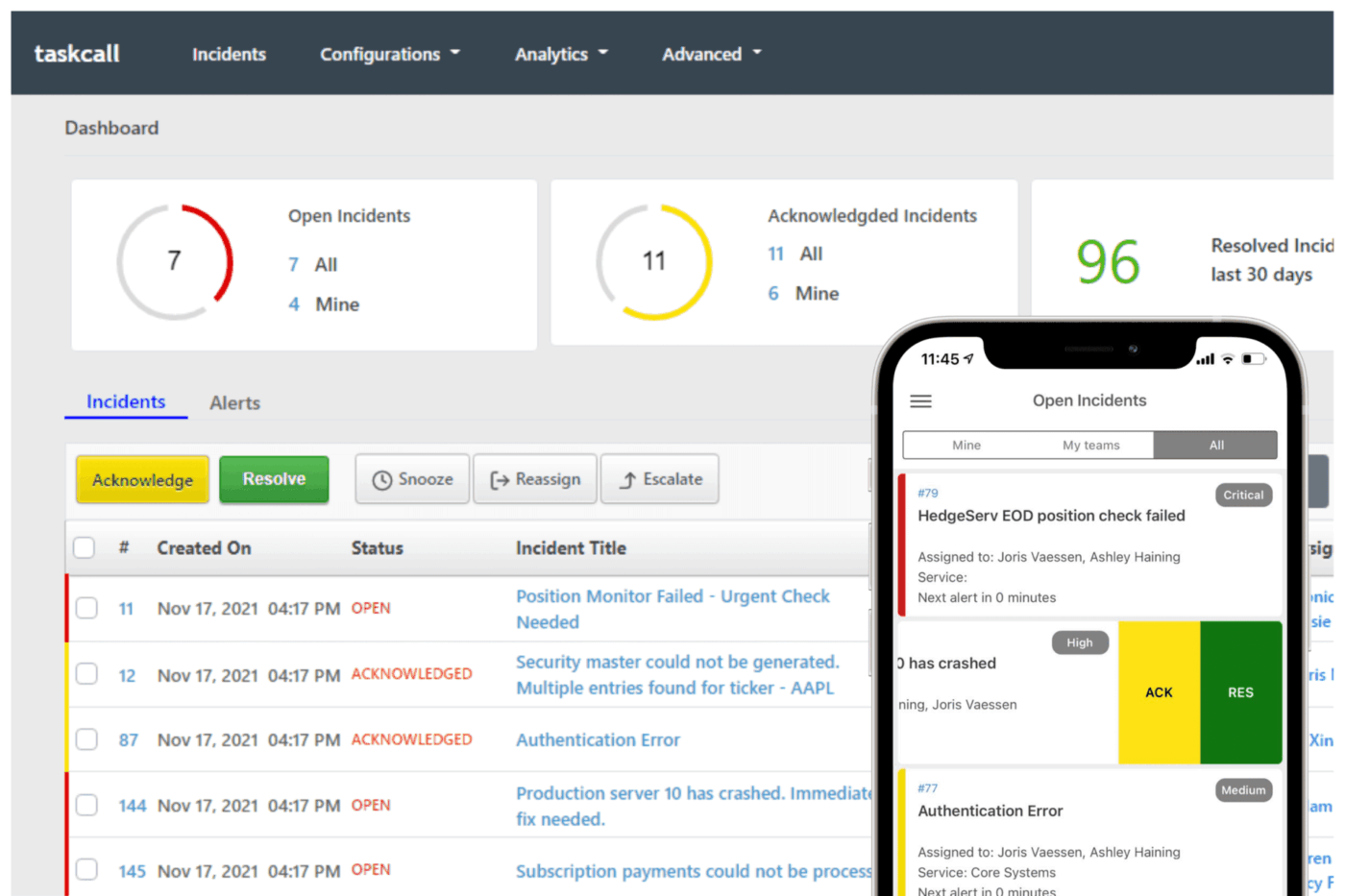
In a recent cyber risk study, incident response was identified as one of the top controls organizations must strengthen to reduce exposure.
That underlines how essential fast, reliable incident workflows have become.
Teams usually stumble not at the alert itself but in the scramble that follows. Who is truly on point right now? Does the alert belong to the app, infra, or customer ops? How do you keep leaders informed without hijacking the fix?
TaskCall tackles those moments directly. On-call is determined from the incident content, so routing lands with the right responder, and auto escalation covers gaps. Notifications arrive by phone, SMS, push, email, or chat.
To trim the noise, event intelligence correlates duplicates and suppresses low-value pings. Context is stitched together by pulling signals from tools like AWS, Datadog, Slack, Jira, and Zendesk, which means engineers see impact and ownership instead of a raw alert stream.
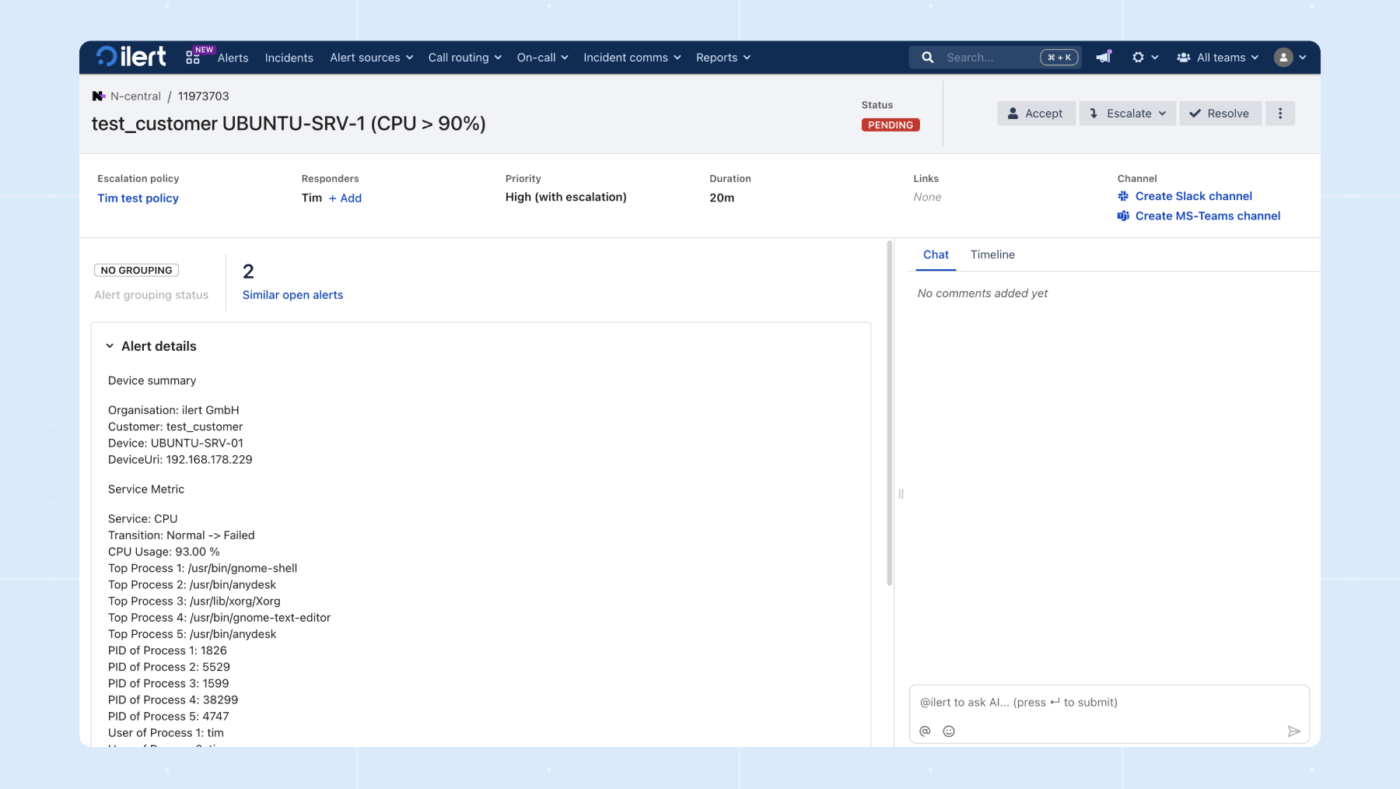
ilert is an on-call management and incident alerting platform with a strong focus on reliability and data privacy. It helps teams ensure that critical alerts from monitoring systems reach the right on-call engineers promptly.
The platform offers flexible on-call scheduling, multi-layered escalation policies, and notifications via numerous channels, including push, SMS, and voice calls.
Routing that respects the current schedule and escalation path means customer calls reach the right person instead of bouncing around a phone tree.
In Slack or Teams, responders work on the incident in chat while Ilert captures context, timelines, and follow-ups.
The AI Voice Agent answers your hotline, collects the right details, and notifies the on-call engineer immediately. Responder analyzes metrics, logs, and recent changes across your stack, surfaces likely root causes, suggests who else to pull in, and even proposes a rollback path for faster mitigation.
You stay in control at every step.
This Capterra review reported:
I find this tool very intuitive and effective for managing standby shifts within IT teams. It offers flexibility by allowing responses directly through the app, SMS, or phone call, which makes it especially practical in real-world scenarios.
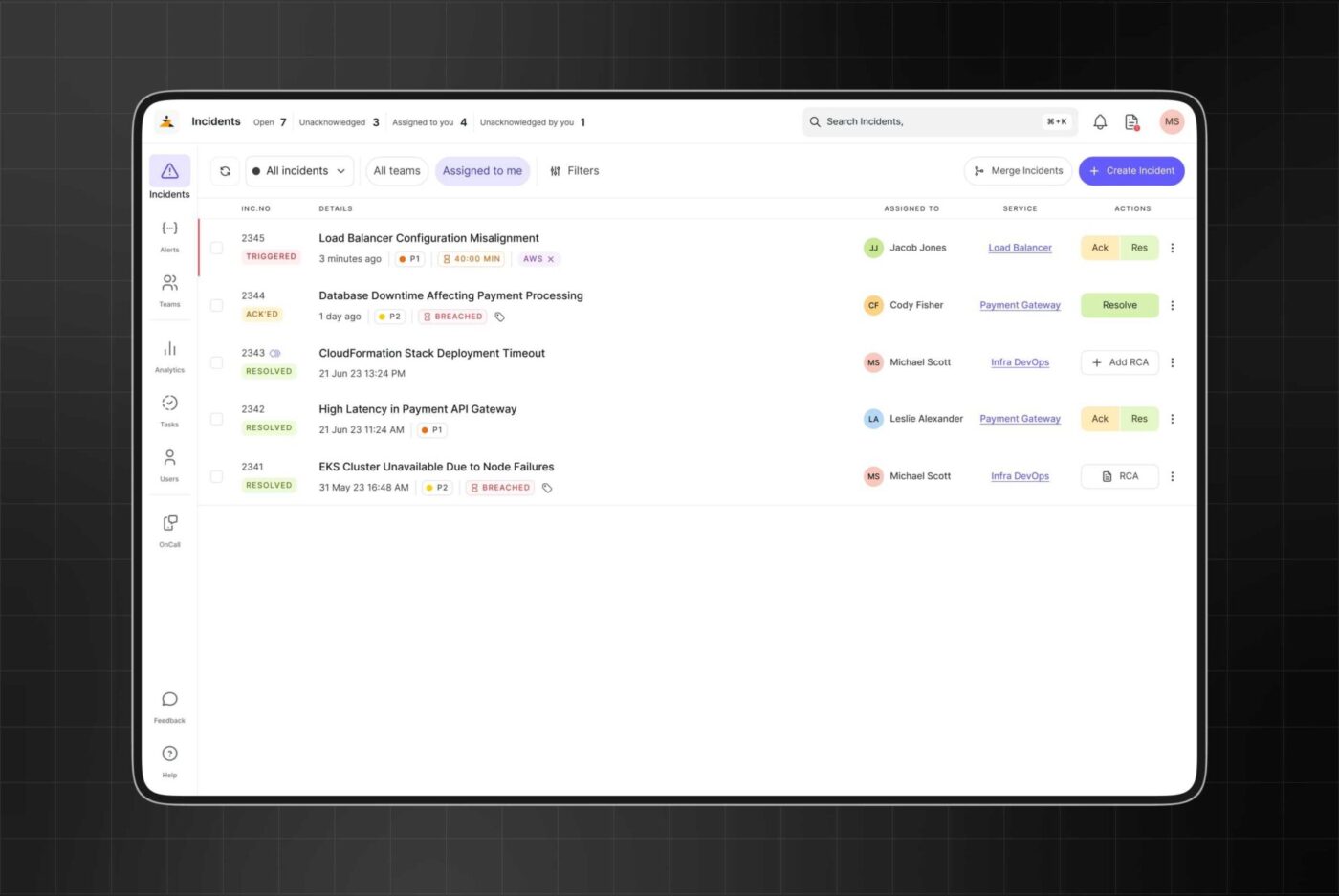
Zenduty helps engineering and DevOps teams stay focused on the signals that matter, cutting MTTR (Mean Time To Resolution) and giving organizations a single, reliable platform to manage incidents.
Users consistently praise the fast and reliable alerts, with push, call, and SMS arriving without lag, so on-call engineers can acknowledge from the notification and get back to work. Teams also like that they can tailor notifications by severity, service, or incident type, so the right person is contacted at the right moment rather than everyone at once.
The platform supports collaborative incident response, with incident roles, task templates, and integrated communication channels. A significant feature is its Incident Command System (ICS) based approach, which provides a structured framework for managing large-scale incidents.
If you’re looking to move from Opsgenie, Zenduty is a good option, with its migration support garnering positive reviews.
This G2 review noted:
What I like best about Zenduty is its analytics-driven insights. By analyzing incidents, we can track trends – such as which days, services, or shifts experienced more issues, identify what went wrong, and determine areas that need improvement.
📖 Also Read: Best IT Operations Management Software
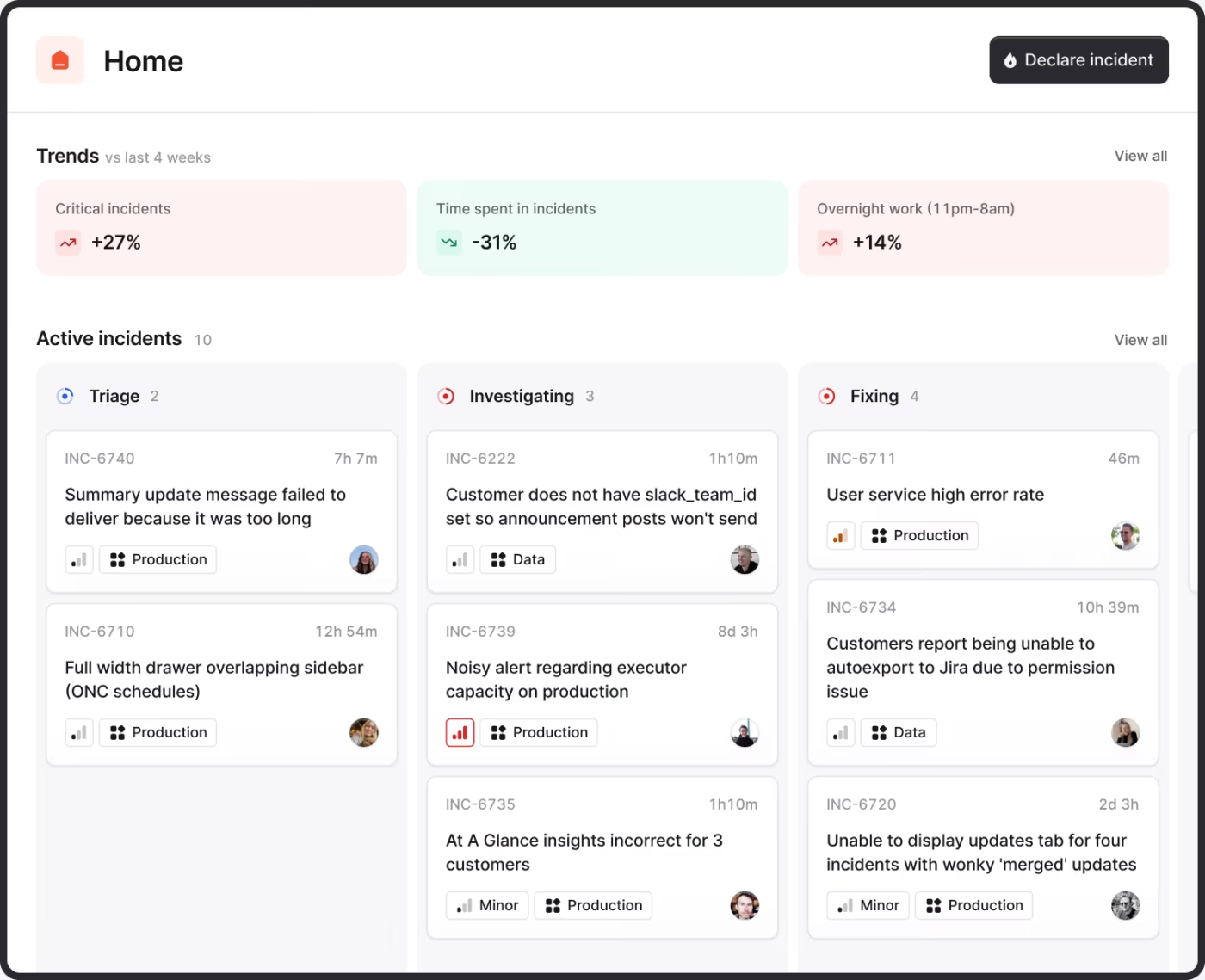
Let’s pretend we are mid-incident for a second. Pager goes off. People wake up. In Opsgenie, you acknowledge, then hunt for the right room, then copy context into yet another place so everyone can see what is happening.
That hop is the moment most teams want to fix. This is where incident.io feels different.
You declare right inside Slack, and a clean space appears with roles, timeline, and the next two or three steps already laid out. You can call, text, email, or just tap to acknowledge. The work starts immediately, and it stays visible.
Users keep describing the same rhythm once they switch. A channel spins up with only the signal you need. The app nudges follow-ups and drafts a crisp summary while you’re still troubleshooting. Status updates for customers are ready to send without leaving the thread. That alone cuts the chatter that usually swirls across side rooms and DMs.
Adoption has been straightforward for teams of very different sizes. Smaller groups talk about wiring it to Linear and New Relic in a couple of weeks and getting real value on day one. Larger orgs share that they rolled it out across multiple teams in roughly a month and did not stall roadmap work to do it.
This G2 review shared:
To me incident.io strikes just the right balance between not getting in the way while still providing structure, process and data gathering to incident management.
💡Pro Tip: Use Prebuilt Agents to answer team questions or share updates, or configure a custom ClickUp AI Agent to monitor task statuses and due dates and send reminders, escalate issues, or update statuses as needed, to move things along.
This video shows you how:
Moving from Opsgenie might feel like packing up a house you’ve lived in for years. Every schedule, escalation rule, and integration has its place, and the thought of carrying it all to a new home can seem daunting.
Atlassian offers an in-app migration tool for moving to Jira Service Management or Compass. The process is structured, predictable, and designed to minimize disruption.
If you decide to go with either of these, you can just review your plan, set your migration date, and let the tool do the heavy lifting. Let’s see how it’ll work, and assess whether this is a good choice for your organization.
Step 1 → Review and choose your path
Evaluate your Opsgenie plan and decide whether Jira Service Management (ITSM-focused) or Compass (developer-focused) is the right fit.
Step 2 → Schedule your migration date
Pick a timeline that works for your billing cycle and team readiness.
Step 3 → Approve billing
Your Atlassian billing admin confirms the plan so the new product can be provisioned.
Step 4 → Data migration in the background
Opsgenie data begins syncing while your team keeps working as usual.
Step 5 → Transition and shut down
You get 120 days to finalize the move before Opsgenie is turned off.
In short, here’s what to expect:
Pros:
Cons:
Here are some thoughts from Redditors on the subject
This Redditor felt the move had worked for them overall:
It didn’t go too bad for us. I do have to look at setting up Roles and permissions again, but everything seemed to cut over fairly well, except if you have exactly the same Jira Team Names as OpsGenies equivalent. They did not merge well and it broke a couple of them. Recommend making sure you change them if you do.
Here’s another who clearly hasn’t had the best experience:
In case somebody considering this option: we switched to Jira Service Management, it is a part of our bundle we already paid (company is saving aggressively). It is so bad, I can’t even explain. Do not consider it as an option.
And another who is already looking to switch again after six months with JSM:
JSM is horrible. It is by no means comparable to PagerDuty, Rootly or Incident.io. We also switched to it about 6 months ago at work and are already looking at alternatives. It is so inflexible, has almost no integrations, does not have good Slack support and the on-call alerts and pages are getting missed by engineers at a pretty high success rate (we never had this problem on OpeGenie).
The other alternative offered by Atlassian, Compass, is not a direct alternative to Opsgenie. Instead, it is a developer experience platform designed to map and manage the components, services, and dependencies of a complex software architecture.
We’d recommend weighing these factors before deciding on the Opsgenie alternative best for your team.
Switching away from Opsgenie can feel like a big step, but look at it as an opportunity to make life easier for your team.
You’ve seen how the other tools stack up, each with its own strengths, but also with its limits.
However, ClickUp quietly wins hearts. 🤗
Here’s why: It brings your tasks, communication, and workflows into one home. You’re not bouncing between screens or patching together separate tools. Instead, your team stays connected, clear on priorities, and confident about what needs to happen next.
Choosing the right incident management solution is not just about alerts—it’s about creating a robust incident management framework that supports long-term operational efficiency. With ClickUp, your team can proactively manage incidents while reducing noise and building consistency across every response.😌
If you’re ready for fewer headaches and more clarity, now’s the moment to sign up for ClickUp!
Opsgenie migrations must be scheduled before April 2027. After that date, Opsgenie data will no longer be accessible.
Some of the strongest alternatives include Jira Service Management, PagerDuty, FireHydrant, TaskCall, ilert, Zenduty, and incident.io. Each offers a different balance of on-call management, automation, and integrations. However, if you want an all-in-one AI-powered platform that keeps your workflows, communications, and documentation in one place, choose ClickUp.
Jira Service Management includes most of Opsgenie’s core features like alerting, on-call scheduling, and incident workflows, but certain advanced functions may differ. Compass is an option for development teams focused on service catalogs and component tracking.
Yes. Atlassian provides an in-app migration tool that moves alerts, schedules, and escalation policies automatically. You can even test the migration in a demo account before committing.
Yes. Tools like Cabot, OpenDuty, and Alertmanager can be customized as open source replacements, though they may require more setup and maintenance.
Costs depend on the platform you choose. Jira Service Management, Compass, and other alternatives offer tiered pricing, often per user per month. Some open source tools are free to use but require infrastructure and support costs.
Yes. Your team can continue using Opsgenie during the migration period, and integrations remain active until Opsgenie is permanently turned off. Afterward, they need to be reconfigured in your new platform.
© 2025 ClickUp